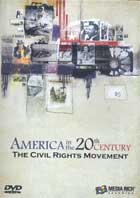
America in the 20th Century: The Civil Rights Movement 2010
Distributed by Media Rich Learning, 3 Cypress Lane, Chesterton, IN 46304; 773-909-7124
Produced by Media Rich Learning
Director n/a
DVD, color and b&w, 86 min.
Jr. High - Adult
African American Studies, American Studies, Education, History, Human Rights, Law, Multicultural Studies
Date Entered: 11/03/2010
Reviewed by Jason R. Harshman, The Ohio State UniversityPart of the America in the 20th Century series, this installment about the Civil Rights Movement begins with a brief overview of the Civil War and traces the evolvement of the Civil Rights Movement through the end of the 1960s. While no new information or theories are uncovered and many of the standard topics, events, and players are included, this program presents an interesting appraisal of the role played by Presidents Truman, Eisenhower, Kennedy, and Johnson in relation to the events that transpired in the southern United States during the 1950s and 60s. This program addresses the political underpinnings—concerns regarding state’s rights and election campaigns specifically—of their decisions regarding the extent to which they wanted or needed to become more involved in what occurred in Arkansas, Mississippi, Alabama, and Tennessee during their respective tenures as president. Of note is the inclusion of footage of a press conference in which President Eisenhower admits his hesitance to become too involved in the issue of civil rights and the actual White House audio recordings of phone conversations held between President Johnson, Senator James Eastland, and FBI Director J. Edgar Hoover regarding the murder of three civil rights activists in Mississippi during the “Freedom Summer” of 1964.
The last chapter of the program focuses on the problems that occurred as part of the Black Power movement and that as the 1970s began, while some progress had been made, black Americans appeared no closer to equality under the law then they were at the end of the Civil War. The program concludes with a tone of unfulfilled promises and missed opportunities, fading out over an image of Abraham Lincoln, insinuating the struggle for equality and civil rights in America had made little headway over one hundred years. While this may at first appear problematic, such a perspective offers educators an opportunity to engage students in an evaluation of what occurred in terms of legislation and the attainment of voting rights and what the civil rights movement means for the state of America today.
For educators interested in a condensed overview of the Civil Rights Movement that aligns with the National Council for the Social Studies (NCSS) standards, this program is divided into eleven chapters and each one lasts between five and eight minutes. Each chapter identifies key vocabulary on the screen followed by a brief definition or explanation regarding the relevance of that term to the civil rights movement. In addition to the names of important individuals and organizations, quotations from contemporary magazines and newspapers, along with excerpts from Supreme Court rulings and federal legislation are included for viewers to read and investigate further using the resources available on the Media Rich Learning web site.